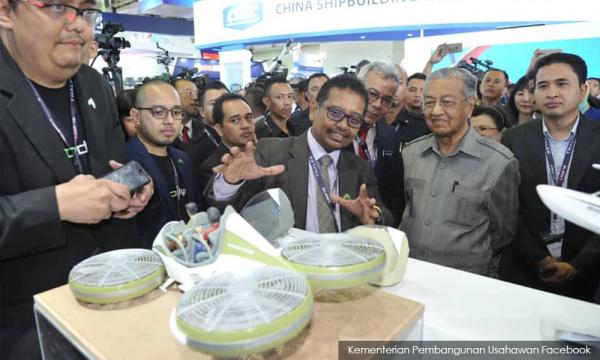ADUN SPEAKS | I have been asked by my peers - is it true that the small-scale prototype of the flying car exhibited at LIMA 2019 was real and not just a made-up fantasy?
To answer that fairly, I made an engineering analysis of the prototype model (based on the scale model that went viral). With no other information.
If I were answering this in front of a class of engineering disciples, I would have to touch upon Bernoulli’s Principle, Newton’s Law, Aerodynamics, Aerothermodynamics, Fluid Mechanics and many more applied physics principles.
I would ask my students to look into the power system, rotor size and design, vehicle design and structural integrity, materials noise and vibration analysis, manoeuvrability, control system, pay-load, power-to-weight ratio, certification and worthiness, dynamic stability, etc. I would have them prove through computation fluid dynamics (CFD).
But in this written piece, I will not do the same. To appeal to the general public, the everyday reader, I will choose to merge my simple answer based on my background as a scientist, an engineer, a researcher, and also as a politician. Thus I will do my best to share my opinion, while eliminating scientific jargon so everything can be communicated clearly.
Firstly, labelling this invention a ‘flying car’ is provocative and sensational. Science and technology should exist on the basis of facts, not gimmicks and sensation. Undeniably, this mislabelling could lead to misinterpretation.
Therefore, it is crucial that those who introduced this as a ‘flying car’ - the inventors and the ministry - rectify its nickname so as to not cause mockery.
That is the challenge of today. Ministers and deputy ministers would not do the invention any injustice to call it a more appropriate name such as ‘vertical take-off transporter’, ‘automobile drone’, ‘drone taxi’, ‘auto hover,’ etc.
An accurate name should be assigned based on the principles applied in launching it into the air, be it through ‘vertical take-off’ as much of the conventional drones on the market are, or just ‘take-off’ as is seen in small planes that have retractable wings.
Secondly, some would ask, is it possible for such a thing to exist? Yes, principally it doesn’t go against engineering and there are already vehicles that are capable of levitating at such a height, such as drones that can support the load of a human.
So this begs the question: is it possible what we witnessed at LIMA 2019 would have the potential to ‘fly’?
If its construction and design adheres and obeys laws and principles of physics and engineering, there would be nothing stopping it from staying in the air. I believe the company who exhibited this has many able and talented technical specialists, but this prototype/model still has a long way to go before it can be applied in our daily lives.
If that was the proposed design, I advise a more serious attempt to make certain it would be able to stay levitated.
Had this been one of my student’s projects, I would make an early comment on the bizarre design of the netting cover on the fan which, in my opinion, would reduce the power that would make it possible for the device to stay up in the air at certain heights.
A critical factor is that the thrust force and power would be able to overcome the load of the vehicle and also it’s payload (whatever the vehicle is meant to hold, eg a human).
This netting cover would only allow air to be expelled through the bottom in a uniform flow, but with the consequence of reduced thrust. This would make it difficult for the device to reach sufficient thrust power to lift it off the ground.
Thirdly, in this new day and age of social media and technology, oftentimes any government initiatives face harsh critique from the public and other authoritative commentators of all sorts of backgrounds and views. Understandable.
Ministers and Deputy Ministers who released statements supporting the vehicle should take note that we as authoritative figures must try (and I say ‘try’ because oftentimes it is hard to control our emotions) to not react impulsively towards snide comments; that is to not respond defensively and negatively. Take note and explain with an open heart.
What if instead, we used words such as: “I understand the critiques and we have taken them into consideration to further improve said vehicle’s design in the future”, “We will provide a sound explanation in the future”, “The technical explanation is so-and-so…”, “The exhibited model was just an example. The final design would be different, more refined and suitable to the vehicle's objectives” and etc.
A quote by one fine former CEO of General Electric, Jack Welch: “People have to trust you. You have to build in trust for people.”
Interesting, right? Objectives are easy to make but to make it work, now that’s the real challenge!
AHMAD SAMSURI MOKHTAR is state assemblyperson for Ru Rendang and Terengganu menteri besar.
The views expressed here are those of the author/contributor and do not necessarily represent the views of Malaysiakini.


